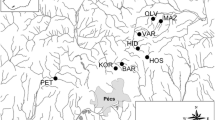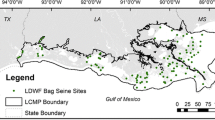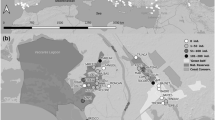Abstract
Density and spatial distribution data of immature Glyptotendipes paripes Edwards (Diptera: Chironomidae), in relation to selected water and sediment characteristics prevailing in three central Florida lakes, were used to develop and calibrate a qualitative model of G. paripes distributions with the purpose of developing more efficient sampling plans for research or population management. For the model, each lake habitat was defined by a two-dimensional matrix, while a three-dimensional matrix was used to simulate the life stage-structured population. A Lefkovitch population matrix was used to project survival and development of the population in each spatial unit. The model incorporated lake bathymetry, sediment dry weight, water level, food availability (as a function of Secchi disk transparency) and strength of density dependence as influences on immature survival and adult fecundity. Temperature-dependent development data for G. paripes were incorporated to estimate development time. A simple redistribution function was used to simulate the dispersal of adults over the simulated habitat for oviposition. Immatures and relevant environmental data taken for eight dates, at each of two other central Florida lakes were used to validate the model. The mean correct prediction rate of the model for field density distributions within 0.5 log(n+1) immatures/m2 density in spatial habitat cells was 0.64 and 0.66 for the validation lakes. Presence/absence correct prediction rates were 0.61 and 0.76, while matching to a proposed sampling stratification based on a treatment threshold was 0.85 and 0.88. These values indicate that the model is efficient for preparing stratified immature G. paripes sampling plans for central Florida lakes.
Similar content being viewed by others
References
Allen, J. C., C. C. Brewster, J. F. Paris, D. G. Riley & C. G. Summers, 1996. Spatiotemporal modeling of whitefly dynamics in a regional cropping system using satellite data. In Gerling, D. & R. T. Mayer (eds), Bemisia 1995: Taxonomy, Biology, Damage Control and Management. Intercept, Andover: 111–124.
Allen, J. C., C. C. Brewster & D. H. Slone, 2001. Spatially explicit ecology models: A spatial convolution approach. Chaos Solitons and Fractals 12: 333–347.
Ali, A., 1995. Nuisance, economic impact and possibilities for control. In Armitage, P. D., P. S. Cranston & L. C. V. Pinder (eds), The Chironomidae: The Biology and Ecology of Non-biting Midges. Chapman and Hall, London: 339–264.
Ali, A., 1996. Pestiferous Chironomidae and their management. In Rosen, D., F. D. Bennett & J. L. Capinera (eds), Pest Management in the Subtropics: Integrated Pest Management-A Florida Perspective. Intercept, Andover: 487–513.
Ali, A. & R. C. Fowler, 1985. A natural decline of pestiferous Chironomidae (Diptera) populations from 1979 to 1984 in an urban area of central Florida. Florida Entomologist 68: 304–311.
Ali, A., W. D. Gu & R. J. Lobinske, 1998. Spatial distribution of chironomid larvae (Diptera: Chironomidae) in two central Florida lakes. Environmental Entomology 27: 941–948.
Ali, A., S. R. Stafford, R. C. Fowler & B. H. Stanley, 1984. Attraction of adult Chironomidae (Diptera) to incandescent light under laboratory conditions. Environmental Entomology 13: 1004–1009.
Anonymous, 1977. Economic Impact Statement. Blind Mosquito (Midge) Task Force, Sanford Chamber of Commerce. Seminole County, FL.
Brewster, C. C. & J. C. Allen, 1997. Spatiotemporal model for studying insect dynamics in large-scale cropping systems. Environmental Entomology 26: 473–482.
Brewster, C. C., J. C. Allen, D. J. Schuster & P. A. Stansly, 1997. Simulating the dynamics of Bemisa argentifolii (Homoptera: Aleyrodidae) in an organic cropping system with a spatiotemporal model. Environmental Entomology 26: 603–616.
Broza, M. & M. Halpern, 2001. Chironomid egg masses and Vibrio cholerae. Nature 412: 40.
Fielding, A. H. & J. F. Bell, 1997. A review of methods for the assessment of prediction errors in conservation presence/absence models. Environmental Conservation 24: 38–39.
Gad El Rab, M. O., D. R. Thatcher & A. B. Kay, 1980. Widespread IgE-mediated hypersensitivity in the Sudan to the ‘green nimitti’ midge Cladotanytarsus lewisi (Diptera: Chironomidae). II. Identification of a major allergen. Clinical and Experimental Immunology 41: 389–396.
Giacomin, C. & G. C. Tassi, 1988. Hypersensitivity to chironomid Chironomus salinarius (non-biting midge living in the Lagoon of Venice) in a child with serious skin and respiratory symptoms. Bolletino First Seroterapico Milan 67: 72–75.
Kagan, S. L., J. W. Yunginger & R. Johnson, 1984. Lake fly allergy: incidence of chironomid sensitivity in an atopic population. Journal of Allergy and Clinical Immunology 73: 187.
Lefkovitch, L. P., 1965. The study of population growth in organisms by stages. Biometrics 21: 1–18.
Lobinske, R. J., 2001. Ecological studies of larval Glyptotendipes paripes (Chironomidae: Diptera) in selected central Florida lakes for creating an exploratory temporal and spatial model of nuisance populations. Ph.D. Dissertation, University of Florida, Gainesville, FL.
Lobinske, R. J., A. Ali & J. Frouz, 2002a. Ecological studies of spatial and temporal distributions of larval Chironomidae (Diptera) with special emphasis on Glyptotendipes paripes in three central Florida lakes. Environmental Entomology 31: 637–647.
Lobinske, R. J., A. Ali & J. Frouz, 2002b. Laboratory estimates of degree-day developmental requirements of Glyptotendipes paripes (Diptera: Chironomidae). Environmental Entomology 31: 608–611.
Lobinske, R. J., C. E. Cichra & A. Ali, 2002c. Predation by bluegill (Lepomis macrochirus) on larval Chironomidae (Diptera) in relation to midge standing crop in two central Florida lakes. Florida Entomologist 85: 372–375.
Ricker, W. E., 1954. Stock and recruitment. Journal of the Fisheries Research Board of Canada 11: 559–623.
Stevens, M. M., 1998. Development and survival of Chironomus tepperi Skuse (Diptera: Chironomidae) at a range of constant temperatures. Aquatic Insects 20: 181–188.
Xue, R. D., A. Ali & R. J. Lobinske, 1994. Oviposition, hatching and age composition of a pestiferous midge, Glyptotendipes paripes (Diptera: Chironomidae). Journal of the American Mosquito Control Association 10: 24–28.
Author information
Authors and Affiliations
Rights and permissions
About this article
Cite this article
Lobinske, R.J., Stimac, J.L. & Ali, A. A spatially explicit computer model for immature distributions of Glyptotendipes paripes (Diptera: Chironomidae) in central Florida lakes. Hydrobiologia 519, 19–27 (2004). https://doi.org/10.1023/B:HYDR.0000026481.31107.30
Issue Date:
DOI: https://doi.org/10.1023/B:HYDR.0000026481.31107.30




